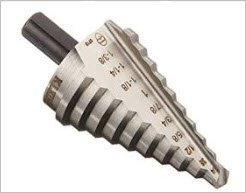The guys are amusing, don't get me wrong I love this site, One can learn so much here and, unlike some others, it is friendly What I find amusing is the way they go on about spotting drills as if it was the end of everything in the world of machining. Like i said before the only spotting drills I had ever heard of were the ones we had to make as a project as apprentices. Some people call them step drills, They are used to spot face a surface around a drilled hole, particularly on a casting, so that a bolt has a flat square surface to tigten against, I still have my set They were also used to countersink holes for SHCS to set below the surface, My set of five drills is designed for 1/4", 5/16", 3/8", 7/16" and 1/2" SHCS.
I can't help but think the guys have never done it tough, and had to make do with the tools at hand. Most of the machines we had when I was an apprentice were known as "Wartime finish". which meant no time, money, or effort was used in making them look nice, sure,they worked fine and were good machines, they just looked unfinished, and that is how they stayed.
There were of course no digital instruments at all. No DRO's No CNC, every thing was done manually A few of the toolmakers had their ownn 6" or150 mm vernier calipers, most of our toolmakers were imigrants from war torn europe, out of 12 toolmakers only two were Australian born and trained, another three were from UK, and the rest came from various parts of Europe. In many ways probably the best apprenticeship a guy could have, as we were exposed to all the different engineering cultures of that time. Everyone had a 1" or 25mm mic, for larger sizes we had to get the 0 - 6" mic from the tool store, this mic had a set of changable fixed anvils that would allow it to be set up to measure all sizes from 0 to 6" I could go on, but I'm sure you get the picture



